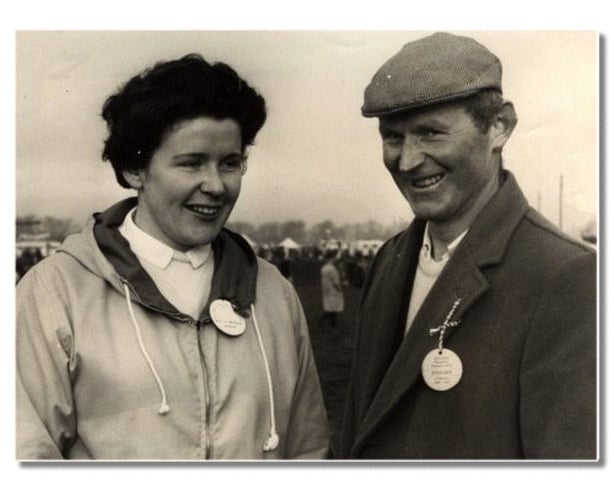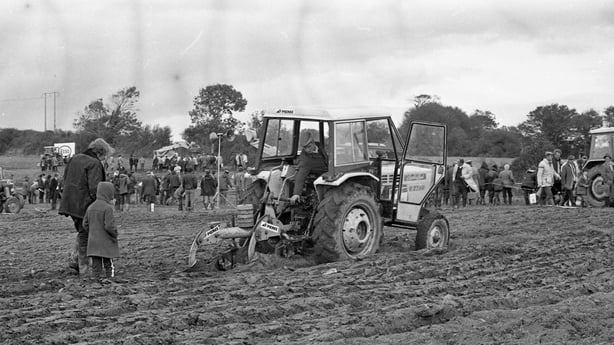Analysis: It began with a good natured disagreement between two farmers and is now one of the biggest events of the year
J.J Bergin from Athy, Co. Kildare and Denis Allen from Gorey, Co Wexford were two lifelong friends and farmers. Each of the men believed their county had the best ploughmen Ireland had to offer. They debated back and forth, but inevitably, there was only one way to settle the matter: a bit of healthy competition.
Local ploughing matches between neighbouring parishes were common and one of the earliest records tell of a match in Camolin Park, Wexford on October 20th, 1816. But the idea of a competition at the inter-county level was new.
Excited at the prospect of a challenge, Bergin and Allen set about contacting tillage farmers in other counties. The interest was considerable. On Monday, February 16th 1931, competitors from nine counties met in Mr WK Hosie's field at Coursetown in Athy, for what would be the very first National Ploughing Championships.
We need your consent to load this rte-player contentWe use rte-player to manage extra content that can set cookies on your device and collect data about your activity. Please review their details and accept them to load the content.Manage Preferences
From RTÉ Archives, in an episode of 'Provincial News Round Up from 1958,' founder of The National Ploughing Championship J.J Bergin says he is confident for the future of the event
The cost of running it that year was £9 pounds, 3 shillings and 5 pence (around €830 in today's money). The competing counties formed a committee and drew up rules and regulations, with the main aim being "to bring the message of good ploughing to all parts of the country and to provide farmers with a pleasant, friendly and appropriate place to meet and do business." The National Ploughing Association was born, and so was "the Ploughing".
Having held the first championships in Bergin’s home county of Kildare, it was only fair that the second event in 1932 was held in Allen’s Wexford. 3000 people attended the festivities in Gorey, and such was the enthusiasm that two ballads were composed, one about the champion ploughman from The Ballagh in Wexford, Michael Redmond.
By 1934, just four years after its conception, the number of counties competing had increased from nine to 17. By 1955, when the cost of running the event was £2,327 pounds, 10 shillings and 7 pence (around €214,759 now), it had grown to such an extent that it became a two-day event.

The early 20th century was a time of great change for Ireland and for farmers. In these early decades, traditional horse ploughing was still dominant on farms and at the Ploughing, but mechanisation was on the way. In 1942 the first tractor ploughing class was introduced, and a transformation in the 1940s and 1950s saw "the demise of the horse and the growth of horse power".
In the midst of all this transformation, a woman who would become known as the reigning Queen of the Ploughing joined the NPA. In 1951, Anna May McHugh from Ballyadams in Co. Laois, aged just 17, started work as secretary to Managing Director J.J Bergin. She would eventually be made secretary of the whole association in 1955. When Bergin died in 1958, All Ireland winner and hurling star Sean O'Farrell took over as MD, and held the position until his death in 1972.
But at this point, in what could comfortably be called an unprecedented move, at a time when a woman’s place was still seen, very firmly, as being in the home, Anna May was appointed MD in May of 1973, while also retaining her position as secretary. Seven decades later, she’s still at the top of the association, aged 90.

Hardy, is one thing you could say about Anna May, according to her daughter, Anna Marie McHugh, General Secretary of the World Ploughing Organisation and National Ploughing Association Assistant Managing Director. "You'd never get the impression from her that she thought "I'm not fit for this"." The board and directors "always believed she was taking the right angle. That gave her the confidence too to make the changes and the development that she did."
From a small field of 26 acres in 1931, the National Ploughing Championship today requires over 700 acres of land: 180 acres for ploughing, 100 acres for trade stands and exhibition space, 400 acres of car parking, and around 25 acres for a demonstration area. In 1988 it became a three day event, as it is now, to help ease the traffic congestion. More than 1,700 exhibitors take part in the Ploughing, while more than 250,000 people typically visit each year.
The event itself has transformed utterly since the argument between the two farming friends. Some notable additions during the years are the introduction of a "Farmerette" ploughing class for girls and women in 1954; the national bread baking competition 1959; the fashion show in 1981, and the livestock section in 1987.
We need your consent to load this rte-player contentWe use rte-player to manage extra content that can set cookies on your device and collect data about your activity. Please review their details and accept them to load the content.Manage Preferences
From RTÉ Archives, in 1995, Anna May McHugh talks about transforming an empty field into the countries biggest agricultural event
Today, the event’s sheer size and variety lends to its enduring popularity. It’s surely one of the few places where you can buy a tractor, bump into the President of Ireland, and grab a few free pens along the way.
The ploughing has evolved too. You’ll see loy digging (the ancient art of turning the soil) horse ploughing (as it was in 1931), vintage tractor ploughing (with what was the modern machine in the late 1940’s), conventional ploughing (using a two-wheel drive tractor), and reversible ploughing (using highly automated tractors). There are more than 320 competitors in the national finals, across the 19 different classes of ploughing.
If you ask McHugh, the ploughing remaining at the core of it all is behind the endurance: "It’s a national competition, it’s an international competition at this stage. It's a sport. There’s something about competition that warms the blood, it gets people livened up."
And, we’re very good at it. Ireland has won both competitions at the World Ploughing Championships back-to-back, for three years in a row now. We also won at the 2024 European finals. "So we're at the top of our game in ploughing," she says. When the hundreds of competitors meet again at the Ploughing in Ratheniska next week, "everybody has to believe that it could be their turn. And it could be, because you go out to turn a sod and nobody knows [what could happen]."
At 93 years of age, the National Ploughing Championships now costs in excess of €6 million to run, and is the biggest National Ploughing Championships in the world, which is "really kind of remarkable," says Dr Mícheál Ó Fathartaigh, who works at the Archives of Rural History in Bern and is a member of the Social Sciences Research Centre at University of Galway. "It shouldn't be as successful as it is, when you think about the trajectories that other countries have gone on. We really buck a trend."
We need your consent to load this rte-player contentWe use rte-player to manage extra content that can set cookies on your device and collect data about your activity. Please review their details and accept them to load the content.Manage Preferences
From RTÉ Archives, The National Ploughing Association celebrate 50 years in 1981 and hosts the World Championships at Wellingtonbridge in Wexford
"The success of [the Ploughing] as an event in many ways reflects the success of the Irish agricultural revolution of the 20th century: this remarkable transformation from Ireland being a place synonymous with a relatively backward version of agriculture at the beginning of the 20th century, to a place synonymous, by the end, with a very progressive sector. The success of the Ploughing really parallels that, but it's also symbiotically linked to it."
"There's great esteem associated with the Championships. What I think that reflects is that Ireland, despite the wider transformation in Irish life and society, remains a very rurally orientated country," says Ó Fathartigh. "It’s successful and it reflects a vitality in rural Ireland that sometimes maybe isn’t captured by the media. Rural Ireland is alive and kicking, and people feel strongly about it."
"There was great minds to actually work out all that detail so far back, with no idea, absolutely no concept of the evolution that the association would have over the years," says McHugh. But there was no great plan to be "the biggest gig in town.". "They were going to run a ploughing match, and then they were going to have activities around the match that were of interest to the people going to the Ploughing." A few stands started to emerge, people needed to be fed. "We actually have pictures of little bonfires and people cooking on the bonfire to feed the ploughmen."
We need your consent to load this rte-player contentWe use rte-player to manage extra content that can set cookies on your device and collect data about your activity. Please review their details and accept them to load the content.Manage Preferences
From RTÉ Radio 1's Sunday Miscellany, Margaret Dunne reads her piece I'll See You at The Ploughing
"Back in those days, when people would be going from different parts of the country, people would get a loan of horses in the county where the event was happening. The competition was in Kerry one year and they actually had a huge difficulty, because the horses couldn't understand the accents of the ploughmen that were using them. It caused havoc in the competition."
But through it all, the original mission statement, "to bring the message of good ploughing to all parts of the country", has been at the root. "We’d often get the request, or suggestion that, you have a three day event, why don't you run concerts at night? Why don’t you do something different? And it’s not what the ploughing is about," she says.
Having a nationwide association, along with the hundreds of volunteers and members, is a huge backbone to the event, she says. "The association will be there well into the future. You’d be hoping it’d be there for another 100 hundred years."
Oh and that very first inter-county Ploughing Championship? Wexford won it.
Follow RTÉ Brainstorm on WhatsApp and Instagram for more stories and updates
The views expressed here are those of the author and do not represent or reflect the views of RTÉ








